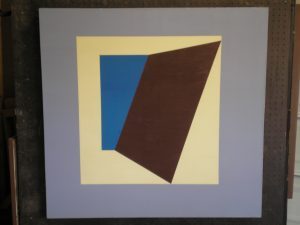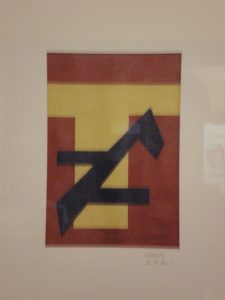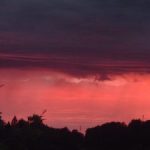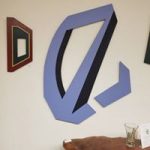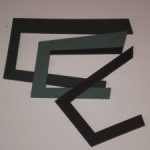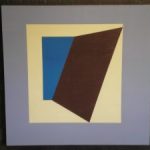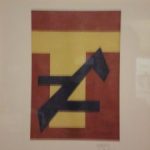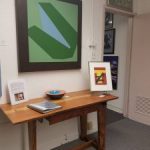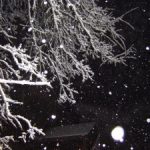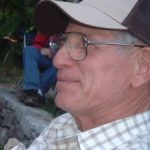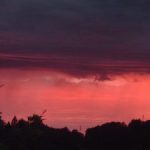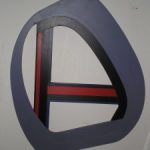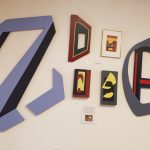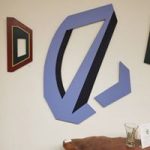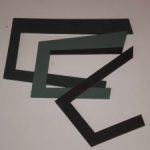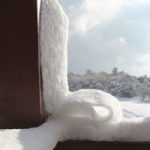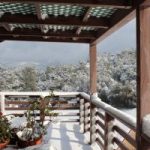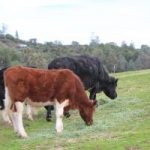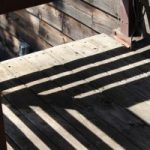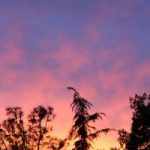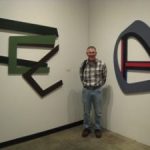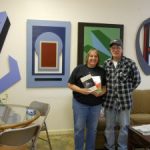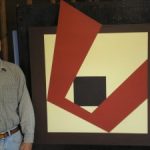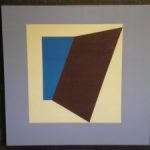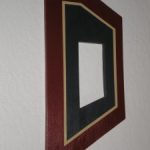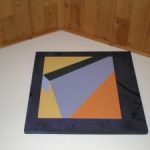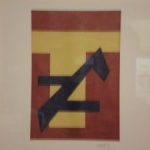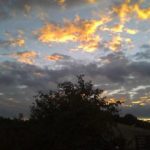Hard-Edge Design – wall sculptures – geometric design
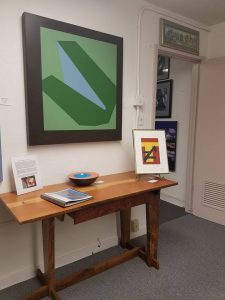
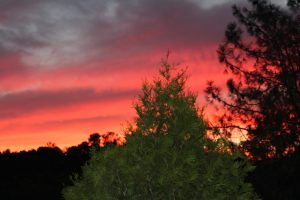
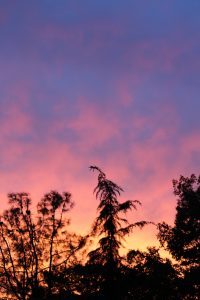
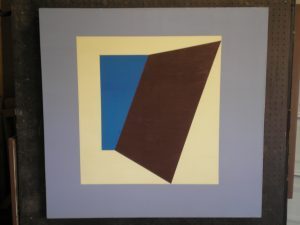
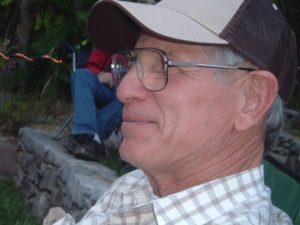
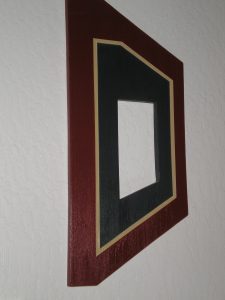

- Gary Rose sunset
- Gary Rose
- Gary Rose
- Gary Rose – acrylic
A Mother Lode Abstract Artist in Angels with Angles
When people come into the Manzanita Arts Emporium gallery in downtown historic Angels Camp, the wall of geometric wall sculptures by artist Gary Rose catches the eye.
“What is it?” they usually ask.
“It looks like calligraphy,” remarks one visitor, stepping back to view the large pieces. “It spells out a word.”
Or not. One image is the letter “D” – another is titled, “The Big E” so viewers aren’t far off. Another work, titled, “The Monk,” with what appears to be part of a red cross embedded inside an iconic hood, carries the strength of powerful symbolism, and it appears to be a letter of sorts. “Keyhole Madonna” presents a portal that may appear to be a tunnel opening for an oncoming train, and then a vague halo shape that may or may not represent a symbolic figure appears, but only the name suggests a deeper connection. Rose does not like to name the works, preferring the use of a series of numbers indicating the date of completion, but the whimsical titles assist in identifying the pieces.
Although Rose’s large 4 by 5 foot sculptures aren’t figurative, as in representing recognizable shapes and images that people are familiar with, viewers fashion biomorphic images from their imagination based on the abstract forms―a natural process. They may see a resting frog, a Grecian helmet, an animalistic shape leaping over a pedestal, a figure of a man stepping out into air. Or something else entirely different depending on their mood or experiences that day. Rose likes the idea that people ignite their own artistic imaginations when they see his artworks.
The sculptural pieces represent an art genre called “Hard-edge painting” – a style or genre of art originated in California in the late 1950s and 1960s that uses an economy of lines and color, abrupt transitions between color fields, smooth surfaces, and a non-representational approach to form.
Rose says that people refer to his work as being Minimalist, another genre of abstract art but explains that his work offers more variation instead of limitations and sparseness that is found in minimalist paintings. Influenced by Bauhaus artists and abstract artists such as Josef Albers, Hans Hoffman, Arthur Dove, Moholy-Nagy, Vasily Kandinski, Piet Mondrian, Walter Gropius, the architect, Frank Stella, as well as myriad forms of Japanese art, Rose also admires the American Precisionists such as Charles Sheeler and Charles Demuth, and movements such as Op Art and Minimal Art, as well as sculptors such as Henry Moore and David Smith. He adds that these influences do not formulate his design style, which developed in the late 1960s and early 70s, as he incorporates personal symbols into his work. (link to information about the art form ).
Rose’s artistic vision encompasses personal icons, he says, and his design sense is flavored by the natural world that he embraces—the dynamics of cattle grazing, mountain curves, sharp tree lines up against rock formations, , anomalies in wood, rolling hills, water movement, and a sense of space and vista. “I take inspiration from what I see around me – the deep green hills in the spring, golden grasses waving in the summer, the grays and blues of river boulders, the deep blues of alpine lakes.” He says that his paintings are meant to be “positive and uplifting and reflect the American tradition of organic, mechanical or architectural majesty.”
His method is quite involved. Rose prepares the wood sculptures from plywood, cutting and sanding to size, priming and masking off the color fields, then uses several layers of acrylic paint, building up the surface so that if you were to gently run a finger across the dried painting, you would feel the three-dimensionality of the raised lines that divide the large color fields, thus creating a “hard edge.”
(Link to samples online – these are samples from other artists that are gaudier than Rose’s works)
All of the fields have several colors mixed into them, with a formula that is difficult to repeat when mixing large amounts of paint required. “The colors have to be right on,” says Rose. “The paint dries fast, and you have to build the layers so that the brush strokes aren’t visible, yet the colors are even and smooth, nearly perfect.” He gestures to one of his works. “If one color is off, the whole thing is off.” He grins. “It’s a lengthy process, done in stages, with the weather cooperating.” He adds, “I could tell you about the importance of line,” he laughs, “but that would take a long time to dry.”
Trained as a studio artist with an art history minor in college, Rose has shown in installations such as the Fresno Art Museum, with his work in private collections, but as a bit of a recluse, he “prefers to show his work in the gallery in Angels Camp where visitors from all over the world, as well as our own community members, can view and enjoy it, perhaps adding to their own art collections.”
Rose moved his family up to the Calaveras foothills in 1983, after having spent a short stint living near the Kings Canyon area east of Fresno, and prior to that, growing up in Los Angeles. Spending time roaming the Baldwin Hills as a boy, before LA lost its wide open spaces, he said he often dreamed of someday having a small ranch, living a rambling Gene Autry inspired kind of life. Choosing Calaveras County, with its rolling hills and vistas, building his own home from scratch and with his own hands, and seeing his children grow up in a relatively safe environment, was all part of the plan. In the meantime, monumental art pieces began to take shape in his studio, covered the walls of his family home, and found their way out into the public eye.
A recent visitor to the gallery, a university art instructor from New York, took one look at Rose’s work and said to the gallery director, “What’s he doing here, in this small town – he should be showing in large installations in San Francisco and New York.” The visitor went on to say, “This is exceptional work of high quality and sophistication, as good as it gets—this guy has got to get noticed.” When the gallery director later told Rose about what the visitor said, Rose grinned, “I’m just now getting a website going,” he laughs, with a twinkle in his eye. “I don’t design these pieces just to market them. They represent an act of creation, like children.” Rose says he likes to keep a low profile and that he takes pleasure in others’ enjoyment of the unusual pieces, many of them suitable as gigantic logos for mega companies.
The free reception for featured January artist, Gary Rose, was Saturday, January 13, from 4-6 pm. Hors d’oeuvres, wine and cheese, and other libations flowed freely and the public was invited to celebrate and talk to Gary about the minimalist and abstract movements in art and how his work defies labels, yet carries on the tradition of experimentation and bold strides in advancing conceptual art. This article appeared in the Sierra Lodestar in January 2018.
- Gary Rose – Hardedge design
- Gary Rose – Hardedge design – large works
- Gary Rose – hardedge design shaped canvases
Gary Rose was born in New Rochelle, New York. His family moved to Los Angeles, California in 1951 and he has been drawing and painting as long as he can remember. Gary attended El Camino College, and served in the United States Navy from 1966 to 1968. As a Vietnam Veteran he reentered El Camino College graduating in 1972 with an AA degree in Business. While in the business field, he entered California State University, Dominguez Hills, graduating with a BA degree in Studio Art with a focus on painting, sculpture, and a minor in Art History with an emphasis on 20th Century Art. Gary’s hard edge works display a strong formal design background. His works are icons or symbols of his own personal experiences and expresses this through the art elements of light, color, form, line, and space. They are meant to be positive and uplifting and reflect the American tradition of organic, mechanical or architectural majesty. He resides in Calaveras County, California.


OLYMPUS DIGITAL CAMERA

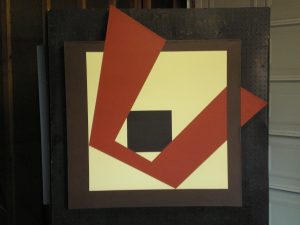
OLYMPUS DIGITAL CAMERA
